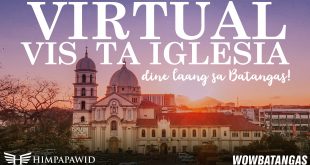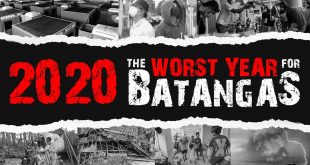No historical account was previously written for the municipality of Rosario, Batangas. The town had an interesting background which was weaved into written history in 1994 when Conrado T. Reyes was tasked to research on the early beginnings of Rosario.
The first published account of the history of Rosario was through the Town Fiesta ’95 Souvenir Program. Let’s turn the hands of time and look back in the early years of Rosario, Batangas — the Agro-Industrial Capital of Southern Tagalog and the Home of Sinukmani Festival.
HISTORY OF ROSARIO, BATANGAS
Accounts show that the origin of Rosario was a Christian settlement along the coast of Lobo. The settlement became prey to the pirate raids during the Moro wars of the 18th century.
The Moro or pirate raids forced the inhabitants of the settlement to the safety of the ravine and forest on the northwest bank of Kansahayan River (now the Municipality of Taysan). Here the settlement was relocated. However, at the height of the Moro Wars in the second half of the 18th century, the Moro vicious Moro raids did reach Kansahayan. In one of their forays the Parish Priest is said to be among those slain.
The inhabitants decided to leave Kansahayan. They headed farther north holding a novena and praying the rosary in the process of their flight. On the 9th night of the novena, the fleeing inhabitants reached the river bank of Tubig ng Bayan (a river originating from Lipa) in now the town of Padre Garcia. Here they finally settled. Living in peace and prosperity, the grateful town’s people erected a stone church south of the river bank in honor of their benefactress, the Lady of the Most Holy Rosary Parish. The town was named Sto. Rosario.
Sto. Rosario was razed to the ground during the Filpino-American War. In the early American Military occupation of Sto. Rosario, a cavalry officer, Captain Ed H. Boughton, came upon the big spring at the foot of Tombol Hill. He decides to relocate the town west of the spring where the poblacion proper of Rosario is now.
Official record show that on June 9, 1902, a council of prominent citizens of the town met under a mango tree beside Tombol Spring. On the spot they formerly organized the municipal government of Rosario. The following distinguish gentlemen assumed the first key positions of the town government, to wit:
Don Geronimo Carandang (Presidente)
Don Diego Rosales (Bise Presidente)
Don Luis Greñas (Secretario)
Don Leon Magtibay (Tesorero)A wealthy landowner, Don Antonio Luansing donated foe the town’s public buildings and plaza.
Local historians were not unanimous as the exact date of the founding of this town. Certainly it was among those organized by the ecclesiastical authorities after the creation of Batangas as a province in 1581. It is generally believed to have come to the existence in 1687 while still located along the coast of Lobo during the term of Don Nicolas Morales as gobernadorcillo. Originally, Rosario comprised the whole parts of the municipalities of Lobo, Taysan, Ibaan, San Juan de Bolbok and the entire municipality of Padre Garcia.
The old settlement in Kansayahan now bears the name of Pinagbayanan, a thriving marketing post in the municipality of Taysan. The old town site of Sto. Rosario had been named Lumang Bayan before it was renamed Padre Garcia when the latter was created and carved out Rosario in 1950 as a separate municipality.
Online Source: www.rosariobatangas.gov.ph/rosario/view/51/history_of_municipality_of_rosario
TOWN PROFILE
Spoken Language: Tagalog, English
Religion: Roman Catholic (94% of population); other religious denominations like Iglesia ni Cristo, Protestants, Aglipay, Islam (6% of population)
Literacy Rate: 90.06% are literate; 9.94% are illiterate
Total Population (as of 2007 NSO Census): 95,785
Geographical Location: Located in the southeastern portion of Batangas province; bounded by Padre Garcia and some parts of Lipa City on the north, San Juan and a part of the Quezon province on the east, Ibaan on the west, and Taysan and Lobo on the south.
Coordinates: 13o57’ N 121o14’ E
Distance from Metro Manila: approx. 93 kms. (thru SLEX via Lipa City)
Distance from Batangas City: 23 kms.
Total Land Area: 27,923.67 ha.
Political Subdivisions: 48 barangays
Alupay
Antipolo
Bagong Pook
Balibago
Bayawang
Baybayin
Bulihan
Cahigam
Calantas
Colongan
Itlugan
Lumbangan
Maalas-As
Mabato
Mabunga
Macalamcam A
Macalamcam B
Malaya
Maligaya
Marilag
Masaya
Matamis (Malinao)
Mavalor
Mayuro
Namuco
Namunga
Natu
Nasi
Palakpak
Pinagsibaan
Barangay A (Pob.)
Barangay B (Pob.)
Barangay C (Pob.)
Barangay D (Pob.)
Barangay E (Pob.)
Putingkahoy
Quilib
Salao
San Carlos
San Ignacio
San Isidro
San Jose
San Roque
Santa Cruz
Timbugan
Tiquiwan
Leviste (Tubahan)
TulosClimate: Wet or rainy season (May to October) and dry season (November to April)
Economy: Agricultural production (Rosario is the Rice Granary of Batangas)
Online Sources:
www.rosariobatangas.gov.ph/rosario/view/17/ecological_profile
www.rosariobatangas.gov.ph/rosario/view/18/physical_and_geographical_location
 WOWBatangas.com Your Source of Great News and Stories from the Province of Batangas, Philippines
WOWBatangas.com Your Source of Great News and Stories from the Province of Batangas, Philippines




